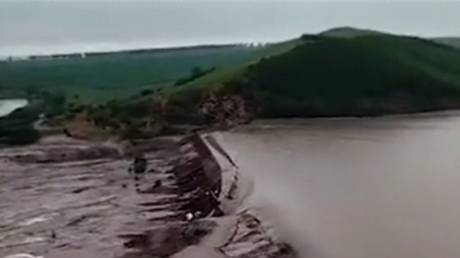
Two dams in Inner Mongolia’s Hulunbuir have collapsed following torrential rain, according to an announcement from China’s water ministry on Monday, citing concerns about the safety risks of aging infrastructure in the region.
The two dams failed on Sunday afternoon after a torrential downpour saw 87 millimeters of rainfall in the area over the weekend and 223 millimeters at a nearby monitoring station. As one of the dams reached maximum capacity, water came over the top before the entire infrastructure was washed away in minutes, resulting in substantial damage.
A video shared by a Chinese individual online shows the moment that water breached the banks of a dam and began flooding out of the reservoir.
Other footage circulating on social media shows water pouring from the dams after their banks were breached, causing destruction and sweeping away infrastructure and flooding fields.
Despite the collapse of the dams and the subsequent flooding, Chinese officials confirmed that locals were evacuated downstream and no casualties have been reported.
The Hulunbuir city government stated on WeChat that around 16,660 people have been affected by the flooding, with at least, 53,807 acres of farmland underwater and infrastructure destroyed in the area.
The flooding left livestock trapped on the border between China and Mongolia. Police were deployed to help more than 1,000 sheep who were surrounded by rising floodwater and took three hours to save the distressed animals.
Earlier this year, China’s deputy water resources minister, Wei Shanzhong, announced at a briefing that nearly a third of the country’s reservoirs have not had a mandatory safety appraisal due to a lack of financial resources.
Throughout China, there are over 98,000 reservoirs used by the country to prevent flooding, generate power and manage shipping but more than 80% of them have been in existence for over 40 years, creating a potential safety risk, according to the government in Beijing.
Think your friends would be interested? Share this story!




